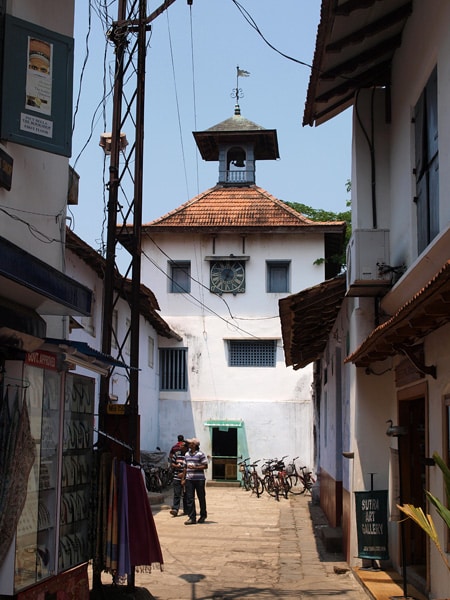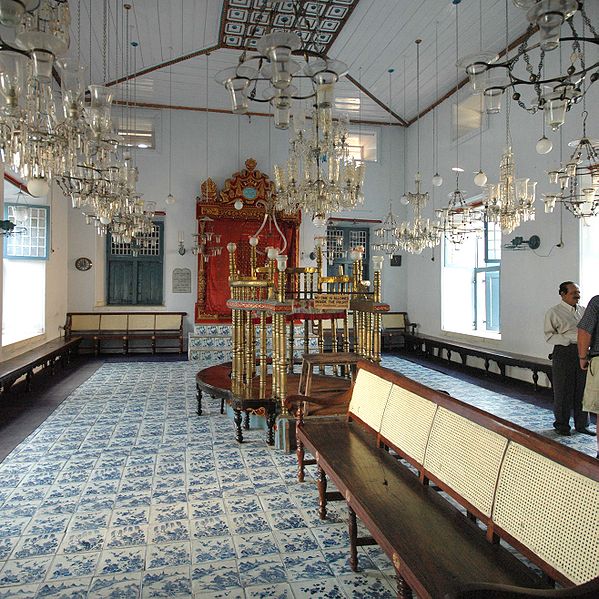The Paradesi Synagogue is the oldest active synagogue in the Commonwealth of Nations, located in Kochi, Kerala, in South India. Constructed in 1568, it is one of seven synagogues of the Malabar Yehudan people or Cochin Jewish community in the Kingdom of Cochin.
Paradesi is a word used in several Indian languages, and the literal meaning of the term is “foreigners”, applied to the synagogue because it was historically used by “White Jews”, a mixture of Jews from Cranganore, the Middle East, and European exiles. It is also referred to as the Cochin Jewish Synagogue or the Mattancherry Synagogue.
The synagogue is located in the quarter of Old Cochin known as Jew Town,[2] and is the only one of the seven synagogues in the area still in use. The complex has four buildings. It was built adjacent to the Mattancherry Palace temple on the land given to the Malabari Yehuden community by the Raja of Kochi, Rama Varma[disambiguation needed]. The Mattancherry Palace temple and the Mattancherry synagogue share a common wall.
HISTORY
The Malabar Jews formed a prosperous trading community of Kerala, and they controlled a major portion of the worldwide spice trade. In 1568, the Jews of Kerala constructed the Paradesi Synagogue adjacent to Mattancherry Palace, Cochin, now part of the Indian city of Ernakulam, on land given to them by the Raja of Kochi. The original synagogue was built in the 4th century in Kodungallur (Cranganore) when the Jews had a mercantile role in Kerala.
The Malabar Jews’ first synagogue in Cochin was destroyed in the 16th century by the Portuguese persecution of the Jews and Nasrani people. The second, built under the protection of the Raja of Cochin along with Dutch patronage, is the present synagogue, which is still in use for worship and can attract a minyan.
It is called Paradesi synagogue because it was built with Dutch patronage; by 1660 the Dutch ruled the Kochi area, calling it Dutch Malabar. In later years, the Paradesi Synagogue was used primarily by the Sephardim (who were also referred to as Paradesi) and their descendants, and later European exiled Jews contributed to the informal name: Paradesi synagogue.
In 1968, the 400th anniversary of the synagogue was celebrated in a ceremony attended by Indira Gandhi, the Indian Prime Minister.
SOCIAL COMPOSITION AND TRADITION
The Paradesi Synagogue had three classes of members:
White Jews were full members. The White Jews, or Paradesi Jews, were the recent descendants of Sephardim from Spain and The Netherlands.
Black Jews, or Malabari Jews, were allowed to worship but were not admitted to full membership. These Cochin Jews were the original Jewish settlers of Cochin.
Meshuchrarim, a group of freed slaves and their descendants brought by the Sephardim, had no communal rights and no synagogue of their own. They sat on the floor or on the steps outside. In the first half of the 20th century, Abraham Barak Salem, a meshuchrar, successfully campaigned against this discrimination.
As is customary for Orthodox Jewish synagogues, the Paradesi Synagogue has separate seating sections for men and women.
Today the Paradesi Synagogue is the only functioning synagogue in Kochi with a minyan.
In conformity with the Hindu, Nasrani, and Islamic traditions of Kerala, the worshippers are required to enter the Paradesi Synagogue barefoot
OBJECTS TO ANTIQUITY
The Paradesi Synagogue has the Scrolls of the Law, several gold crowns received as gifts, many Belgian glass chandeliers, and a brass-railed pulpit. It houses the 10th-century copper plates of privileges given to Joseph Rabban, the earliest known Cochin Jew. These two plates were inscribed in Tamil by the ruler of the Malabar Coast.
The floor of the synagogue is composed of hundreds of Chinese, 18th-century, hand-painted porcelain tiles, each of which is unique. A hand-knotted oriental rug was a gift from Haile Selassie, the last Ethiopian emperor. The synagogue has an 18th-century clock tower, which, along with other parts of the complex, was restored between 1998 and 1999 under the direction of the World Monuments Fund.


